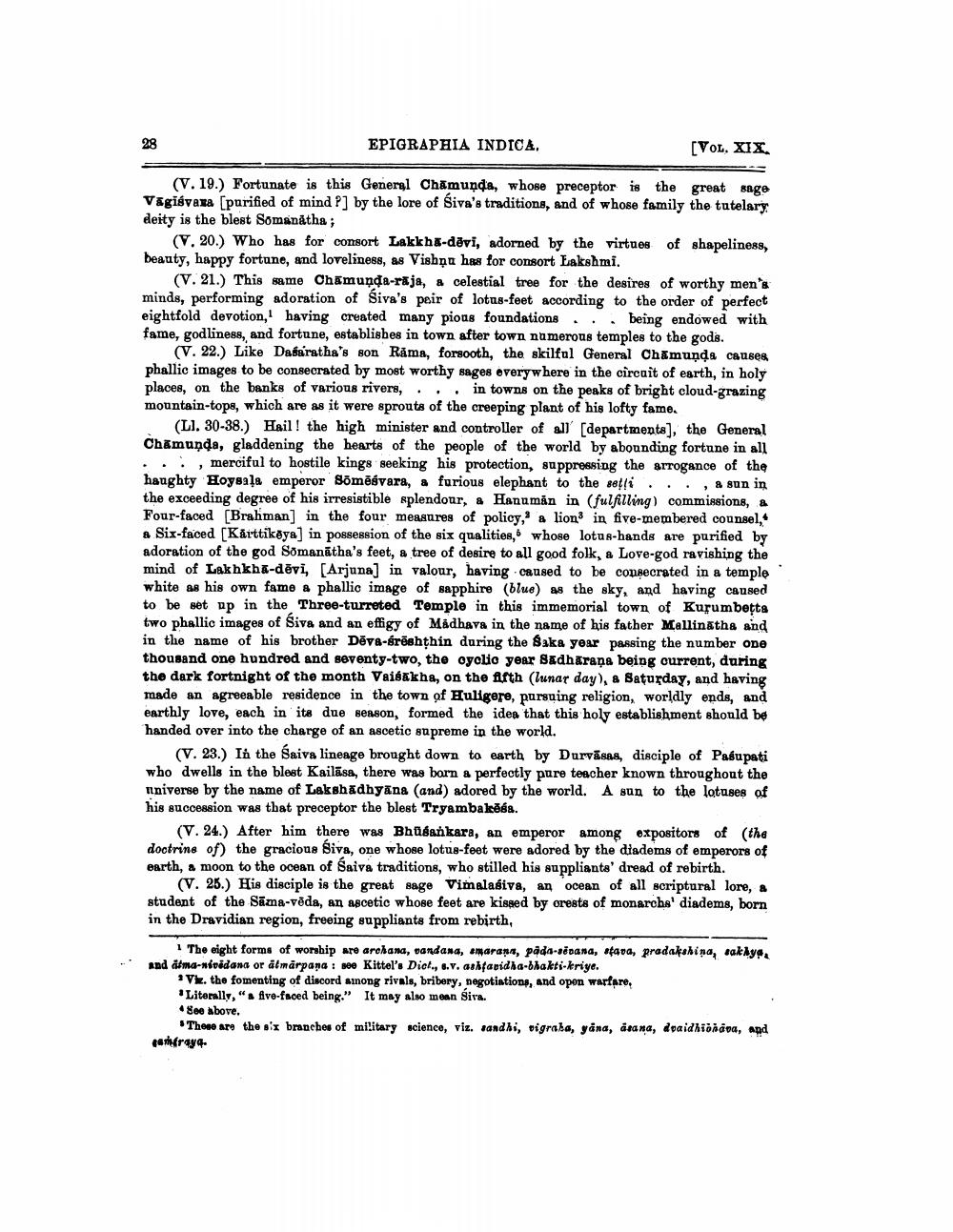________________
28
EPIGRAPHIA INDICA.
[VOL. XIX.
(V. 19.) Fortunate is this General Chamunda, whose preceptor is the great sage Vagisvana [purified of mind ?] by the lore of Śiva's traditions, and of whose family the tutelary deity is the blest Somanatha;
(V. 20.) Who has for consort Lakkha-devi, adorned by the virtues of shapeliness, beauty, happy fortune, and loveliness, as Vishnu has for consort Lakshmi.
(V. 21.) This same Chamunda-raja, a celestial tree for the desires of worthy men's minds, performing adoration of Śiva's pair of lotus-feet according to the order of perfect eightfold devotion, having created many pious foundations... being endowed with fame, godliness, and fortune, establishes in town after town numerous temples to the gods.
(V. 22.) Like Dasaratha's son Rama, forsooth, the skilful General Chamunda causes phallic images to be consecrated by most worthy sages everywhere in the circuit of earth, in holy places, on the banks of various rivers, ... in towns on the peaks of bright cloud-grazing mountain-tops, which are as it were sprouts of the creeping plant of his lofty fame.
(Ll. 30-38.) Hail! the high minister and controller of all [departments], the General Chamunda, gladdening the hearts of the people of the world by abounding fortune in all .., merciful to hostile kings seeking his protection, suppressing the arrogance of the haughty Hoysala emperor Somesvara, a furious elephant to the setli..., a sun in the exceeding degree of his irresistible splendour, a Hanuman in (fulfilling) commissions, a Four-faced [Brahman] in the four measures of policy, a lion in five-membered counsel, a Six-faced [Karttikaya] in possession of the six qualities, whose lotus-hands are purified by adoration of the god Somanatha's feet, a tree of desire to all good folk, a Love-god ravishing the mind of Lakhkha-devi, [Arjuna] in valour, having caused to be consecrated in a temple white as his own fame a phallic image of sapphire (blue) as the sky, and having caused to be set up in the Three-turreted Temple in this immemorial town of Kurumbetta two phallic images of Śiva and an effigy of Madhava in the name of his father Mallinatha and in the name of his brother Deva-éreshthin during the Saka year passing the number one thousand one hundred and seventy-two, the cyclic year Sadharana being current, during the dark fortnight of the month Vaisakha, on the fifth (lunar day), a Saturday, and having made an agreeable residence in the town of Huligere, pursuing religion, worldly ends, and earthly love, each in its due season, formed the idea that this holy establishment should be handed over into the charge of an ascetic supreme in the world.
(V. 23.) In the Saiva lineage brought down to earth by Durvasas, disciple of Pasupati who dwells in the blest Kailasa, there was born a perfectly pure teacher known throughout the universe by the name of Lakshadhyana (and) adored by the world. A sun to the lotuses of his succession was that preceptor the blest Tryambakééa.
(V. 24.) After him there was Bhusankara, an emperor among expositors of (the doctrine of) the gracious Siva, one whose lotus-feet were adored by the diadems of emperors of earth, a moon to the ocean of Saiva traditions, who stilled his suppliants' dread of rebirth.
(V. 25.) His disciple is the great sage Vimalasiva, an ocean of all scriptural lore, a student of the Sama-vēda, an ascetic whose feet are kissed by orests of monarchs' diadems, born in the Dravidian region, freeing suppliants from rebirth,
1 The eight forms of worship are archana, vandana, amarana, pada-seoana, stava, pradakshina, sakhya. and atma-nivedana or ätmärpana: see Kittel's Dict., s.v. ashfaridha-bhakti-kriye.
V. the fomenting of discord among rivals, bribery, negotiations, and open warfare, Literally, "a five-faced being." It may also mean Siva.
See above.
These are the six branches of military science, viz. sandhi, vigraha, yana, asana, dvaidhibhava, and eamfraya.




